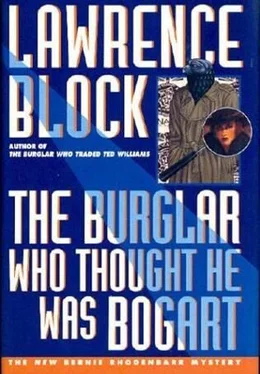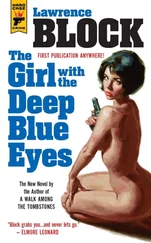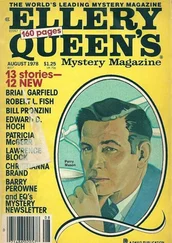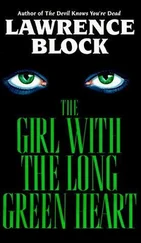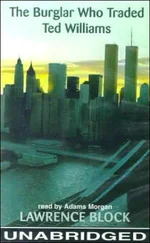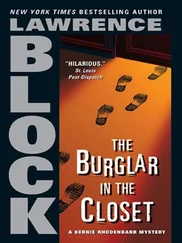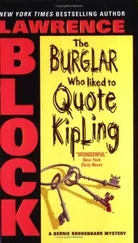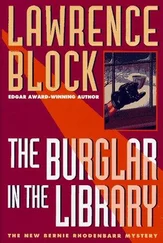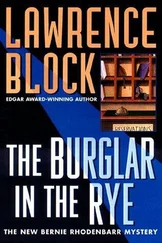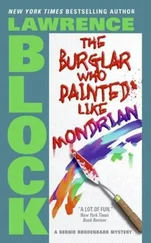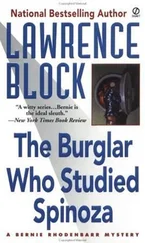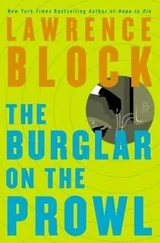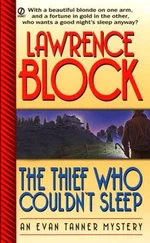4. Maybe, as Carolyn had suggested earlier, Hoberman was dyslexic. He’d written the right letters but got them in the wrong order. I switched them around without coming up with anything more promising than HOPCAB. It was true, to be sure, that the Boccaccio (say) was only a short hop away by cab, but could that possibly be the urgent information Hoberman wanted to pass on to whoever found his body? I couldn’t see it. If I was ready to say the long goodbye and sleep the big sleep, I’d at least try for something profound, like “Life is a fountain,” say, or “Take two and hit to right.”
5. Perhaps, startling as it was to entertain the notion, perhaps CAPHOB was a word. It wasn’t in the dictionary, nor was anything that started out with those first four letters, but suppose it was a proper name. In fact, suppose it was Candlemas’s name. It didn’t much sound like a name, but was it that much less plausible than Souslik or Marmotte? What would you think if you saw either of those written in blood on the side of your attaché case?
6. Was it possible it was just drivel? Consider Dutch Schultz’s famous last words, a great extended monologue duly recorded for posterity as he lay dying. They were words, all right, and some of the sentences even parsed, but the great man had made no sense at all. Suppose the good captain, presented with a small canvas, had managed the neat trick of distilling a whole world of meaninglessness into six meaningless letters.
And so on.
Sometime in the middle of the afternoon I got hungry. I was all set to order Chinese food when I realized it wouldn’t work; I couldn’t open the door to receive it because of the police seals. By this time I was really in the mood for it, too, so I thought about having it delivered to the Lehrman apartment and waiting for it down there. I don’t know what made me think that was a sensible idea. Maybe I’d overdosed on meditation, using CAPHOB as my mantra. Fortunately I nipped the whole enterprise in the bud and raided the kitchen instead.
What I found was leftover Chinese food, but it had been left too long. You wouldn’t want to touch it with a ten-foot chopstick. I toasted a couple of English muffins (the bread was stale) and spread them with peanut butter and jelly (the butter was rancid) and washed them down with black instant coffee (the milk was beyond description). Someday, I thought, when all of this was but a memory, I’d be eating real meals again, hearty coffee-shop breakfasts, overseasoned ethnic lunches with Carolyn, real dinners in real restaurants. For now, though, I seemed destined to grab breakfast on the run, skip lunch or steal it, and make the big meal of the day popcorn. My clothes were neither falling off me nor gripping me too tightly, so I seemed to be getting away with it. But it would be nice to eat like a human being again.
I drank the last of the coffee, rinsed my dishes in the sink, and got back to work.
By the time I was done, I had some calls to make. I sat down in the leather club chair, swung my feet up onto the ottoman, held the receiver to my ear and decided against it. How did I know who had one of those doohickeys on his phone that displays the caller’s number? And how could I be sure that none of the folks I wanted to call would recognize Hugo Candlemas’s telephone number?
No point taking chances. I’d left NYPD seals intact, I’d steered clear of tainted General Tso’s Chicken. After all that, I didn’t want to be hoist on the petard of modern communications technology.
I left the Candlemas residence neat and clean, with no evidence of my visit aside from the peanut butter and jelly I’d scarfed and the fingerprints I’d left behind. (I’d wiped up some after myself, but hadn’t been a fanatic about it; they already had all the prints they were ever going to lift from the crime scene.) To protect the place from the elements, I cut a rectangle of cardboard from a corrugated carton, shrouded it in plastic wrap from a drawer in the kitchen, and carried it and a roll of tape out onto the fire escape with me. There I drew the casement window shut, reached in and latched it, then withdrew my arm and taped the cardboard in place of the missing pane. Then I scuttled quickly and quietly past the Gearhardts’ window and into the Lehrmans’ apartment a flight below.
This would have been rendered more complicated if their houseguest had returned in the interim, but he hadn’t. I closed their window after me, repositioned the jade plant and the bookcase-the planter was definitely Rockwood, I decided-and chose a telephone in the front room, where I could keep an eye and ear on the door.
I made my phone calls.
When I was done I treated myself to a tour of the apartment. Aside from a massive Chippendale highboy and a closet they’d cleared out for him, the Lehrman possessions remained essentially undisturbed during their absence. I window-shopped, leaving everything where I found it, and being much more careful about fingerprints than I’d been two flights up.
I left the refrigerator unopened.
And, when I let myself out at last, I locked up after myself and left the little brownstone house without incident. The blind woman on the first floor might have heard my footfall on the stairs, the neighbors across the street might have seen me emerge from the entranceway, even as they might have seen me go in some hours earlier. But I’d given them no cause to note my passage. I’d come and gone, leaving no trace.
In King of the Underworld, Bogart plays the title role of Joe Gurney. Kay Francis and John Eldredge play a husband-and-wife team of doctors, Eldredge with a mustache almost as unfortunate as Bogie’s in Virginia City . Eldredge saves a wounded henchman of Bogart, who enlists him as the gang’s doctor. When their hideout is raided, Bogart decides Eldredge must have ratted, and shoots him. Bogart and his men get away, but the cops arrest Kay Francis.
Then, in what I thought was a terrific touch, Bogart kidnaps a writer and forces him to ghost his autobiography, planning to kill him when he’s done. First, though, he busts two captured gang members out of jail, gets wounded in the process, and manages to find Kay Francis, who’s been trying to dig up evidence that will clear her at the trial. A big help she turns out to be; she tips off the cops, infects Bogart’s wound, and blinds him with tainted eyedrops. He’s stumbling around the hideout after her and the writer, trying to kill them even if he can’t see them, when the cops burst in and gun him down.
I watched this from my usual seat, with my usual barrel of popcorn on my lap, and what was becoming my usual second ticket in the hands of the ticket-taker. While I was on line to buy the popcorn I’d caught the eye of the tall guy with the goatee and the glasses. He smiled and looked away quickly, not wanting to stare at the poor loser who was all by himself once again. Reflexively he slipped an arm around the barely perceptible waist of his girlfriend, the Pillsbury doughgirl. I guess he wanted to make sure she couldn’t get away, lest he wind up like me.
A lesser man than I might have felt sorry for himself.
During the intermission I stayed right where I was. I had plenty of popcorn left, and I didn’t need to use the john or duck out for a quick smoke. I stayed put, and after a decent interval the lights went down again and the second feature began.
Beat the Devil. Directed by John Huston, who shared the screenplay credit with Truman Capote. The cast included Gina Lollobrigida as Bogart’s wife and Jennifer Jones as a compulsive liar married to a fake English nobleman. Peter Lorre’s in it as well, along with Robert Morley and a bunch of great character actors whose names I can never remember.
I settled into my seat, thinking that maybe this time I’d be able to understand what was going on on the screen. I must have seen the movie three or four times over the years and was never able to make head or tail out of it. Everybody was trying to hoodwink everybody else, and when Jennifer Jones prefaced a statement with “in point of fact” you knew for certain she was about to come up with a whopper, but beyond that I could never quite manage to follow the plot. Maybe this time would be different.
Читать дальше
